There is no doubt that Boer goats make for great farm animals. They are incredibly versatile and can provide a lot of benefits for homesteaders.
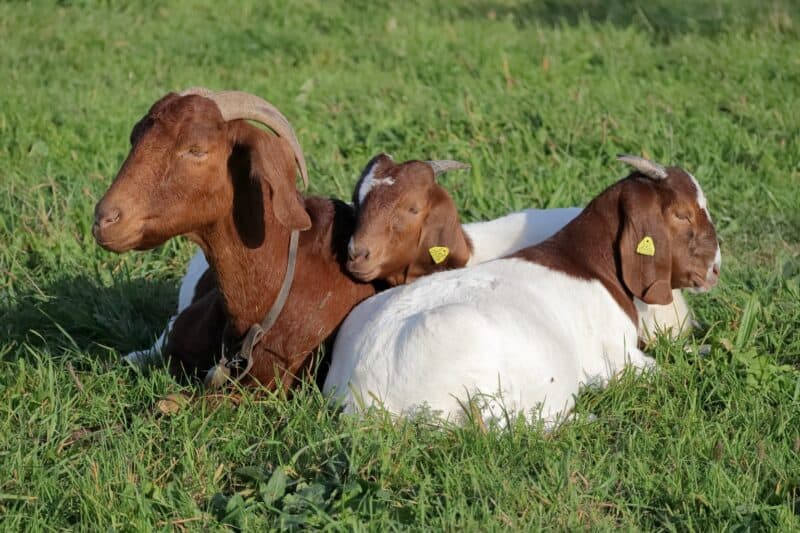
If you are thinking about adding these creatures to your land, then it is important to learn how to raise Boer goats step by step.
Are you interested in learning how to raise Boer goats? If so, you’ve come to the right place. In this blog post, we will walk you through the step-by-step process of raising these animals.
We’ll provide you with all the information you need to get started, including tips on fencing, feeding, and housing. So if you’re ready to become a goat farmer, keep reading!
Table of Contents:
What is a Boer Goat?
The Boer goat is a unique breed of goat that originated in South Africa. It was created by crossbreeding various breeds of indigenous goats with the ultimate goal of meat production.
We haven’t had Boer goats here in the United States for very long. In fact, the first Boer goats weren’t brought over here from New Zealand until the 1990s.
Since they were bred specifically for high growth rate, fertility, and body shape, Boer goats have large frames and produce more muscle. They put on body weight at a faster rate than other types of goats.
Not only that, but they spend more time grazing than other goats – they are constantly eating! – and they graze on land that often isn’t suitable for dairy goats.
They’re easy to raise, affectionate, and mild-tempered – perfect if you’re a goat farmer who is looking for a breed that is easy to raise. They are hardy in most climates, including very hot and very cold temperatures.
These animals have white bodies with red-brown coloring. They have pendulous ears and often have thick, dark horns that curl backward.
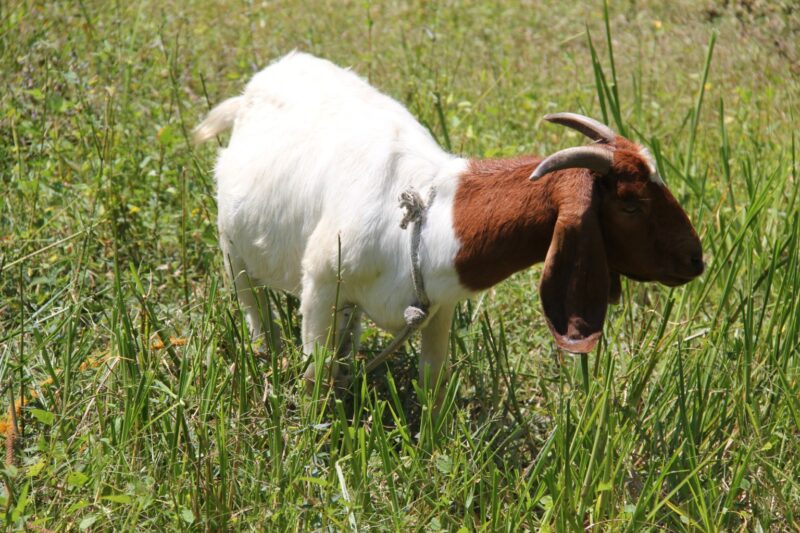
Choosing the Right Boer Goats
When starting a Boer goat herd, consider your goals. Are you raising them as pets, or do you want to start a business with your goat farm?
If you plan on raising your goats for profit, you’ll want around 25 does and 1 buck. Get your goats from a well-established breeder who understands the breed well. That way, you can get a good idea of the health and breeding history of the animal.
The hair should be glossy and smooth, since rough hair can indicate poor nutrition, disease, or a parasite load.
The eyes and nose should be clear with no mucous and the breathing should be clear, without any coughing.
Take a look at the goat and see how it’s walking. If it’s limping, that’s a major red flag. The hooves might need attention.
If you’re buying it, try to avoid purchasing those that are within 30 days of their due date or that had kids die within the last 30 days. They have lower immunity. Avoid older does that have never kidded, since they may be infertile.
It’s okay to buy cross-bred does, but avoid cross-bed bucks. They can take after the non-Boer grandparent and lose desirable characters that you want in your herd.
Finally, if it matters for the goals of your farm, you may want to look only for registered Boer goats. This is important if you are using the goats for exhibition purposes.
What Are Boer Goats Used For?
Boer goats are primarily used for meat.
However, they can also be raised as animals for show (exhibition). Boer goats can attend shows and events sanctioned by the American Boer Goat Association. They are also wonderful 4H animals since they are so docile and friendly.
Of course, you can always use Boer goats to improve your pasture, too. They can live on land that is unsuitable for other animals, helping to control weeds like thistles, ragwort, and more.
Some people raise Boer goats for dairy, but not usually exclusively (meaning they raise the goats for some other purpose and the dairy is a side benefit).
They don’t produce quite as much milk as other breeds of dairy goats and it’s also lower in fat.
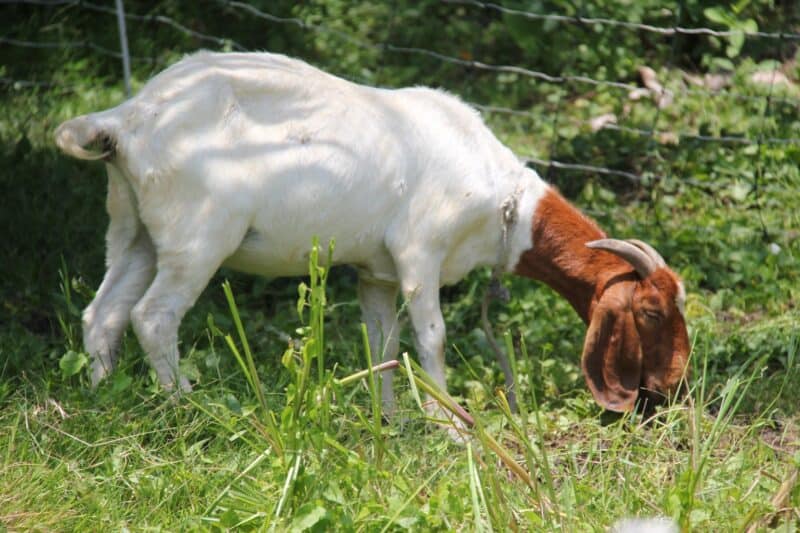
Boer Goat Feeding and Behavior
Many people choose to raise Boer goats because they are super easy to feed. They were bred to live on land considered too difficult for humans to clear by hand, and like most other breeds of goats, forage instead of graze.
They like to eat things that other grazers (like cattle) normally wouldn’t, including tree leaves, brush, and taller weeds and forbs.
They are great pasture companions for other animals since they’ll eat things that others precisely won’t, helping to reduce the risk of disease and parasites.
Therefore, the best feed for your goats is pasture. While they will eat just about anything, it’s a good idea to give them the best quality pasture you can – they’ll grow faster that way.
The diversity they’ll get by grazing good pasture should provide for most of their nutritional requirements.
Of course, you can also provide them with hay during the winter, when plants are scarce.
A grain supplement can be used, but this purchased feed should be provided at a minimum to avoid bloat and other issues.
The best hay for goats will be horse-quality hay composed of species like legumes (like lespedeza and alfalfa), which are higher in protein, minerals, and vitamins.
Grain and other supplement feed should only be supplied if your pasture doesn’t have a diversity of nutritious species, when it’s the winter or during a drought, if your goats are sick or confined due to injury, or if the pasture is too small for your goat herd. You can occasionally feed kitchen scraps.
Don’t forget that you will also need to add a mineral supplement. Provide your goats with a supplemental mineral free-choice. They’ll eat just what they need.
Don’t use mineral supplements for other species, like sheep, because it lacks sufficient amounts of copper.
How to Feed Boer Goats
Goats like to eat from the crowns of shrubs and weeds – therefore, it’s important that you make sure the feeders and waterers are elevated.
Not only that, but you need to find a way to position your feeders so the goats can’t stand on them or destroy them.
Elevate them about 24” off the ground with a horizontal bar about 14” off the ground. That way, smaller, younger goats have a place to stand on their front feet while reaching for food.
Be sure to provide plenty of free-choice fresh water, too – ideally about four liters of water per day but more when goats are lactating or the weather is hot.
Housing and Fencing For Boer Goats
Whenever possible, keep Boer goats in large groups. They are social animals who prefer to group up in herds.
Having just one (or even two, in some cases) goats will lead to unhappy animals who make a lot of noise, are destructive, and are constantly trying to escape.
Each goat will need about 250 square feet per space per animal. It’s not recommended to lock your Boer goats up in a barn.
These animals naturally like to browse, moving from plant to plant. This browsing habit will give your animals the nutrients they need, helping them stay healthy.
It will also reduce the build-up of manure, something that can lead to diseases and parasites. If your goats are too confined, you’ll likely notice a sharp decline in their health.
Fencing
Boer goats, unlike other breeds of goats, are not known for being super high jumpers. They can stand on their hind legs to reach and browse, and kids are more likely to jump and climb than adults.
That said, it’s still a good idea to build a tall fence that will keep the flightiest of your herd contained. Try to make sure the fence is at least four feet high at a minimum.
It should be built out of woven wire so that it can withstand pawing, chewing, and rubbing.
Don’t use barbed wire, since it won’t keep the goats contained and can hurt them. Electric also isn’t advised unless you’re using netting, since you’d need many strands to keep the goats contained.
The fencing needs to have openings that are no larger than 2×4”. Otherwise, the goats can stick their heads through and get stuck on their horns.
Boer Goat Shelter
Like other livestock animals, Boer goats need a sheltered space to escape the wet and windy weather. Goats hate the rain!
Indoors, each goat needs at least 20 square feet of space if there’s no pasture space available. If there is, you can half that number – but again, more space is always better.
A shelter will also provide a place for sick or injured animals to go, even when the weather is favorable.
If you need to isolate one or more Boer goats, it’s a good idea to have a separate isolation pen so you can keep an eye on them. This is especially important during the kidding season.
Another note on housing – and that has to do with bucks. Bucks can be tough to contain during breeding season. The does are polyestrous so they will go into heat simply by being around an animal.
Therefore, you may want to contain your bucks separately in a different pen that does not share a fence with the does (they can breed through it). For your fence posts, use metal T-posts or pipes instead of wood.
It’s also not a bad idea to add a separate strand of electric fencing.
Predator Control
The benefit of raising Boer goats is that they are on the bigger side, so they don’t tend to attract quite as many predators as other breeds of goats.
However, predators are still a concern.
Depending on where you live, you might have to be concerned about wolves, coyotes, bears, bobcats, and mountain lions.
Newborn kids are at risk from foxes and eagles, while even domestic dogs can pose a threat to goats, too.
Make sure your goats have shelter at night and are surrounded by a secure fence. Again, this fence should prevent the goats from escaping but should also guard them against predators.
You may also want to invest in livestock guardian animals. These animals are large enough (and specially trained) to deter predators.
Many breeds, like Great Pyrenees, are also naturally nocturnal, so they can keep an eye on your goats at all hours.
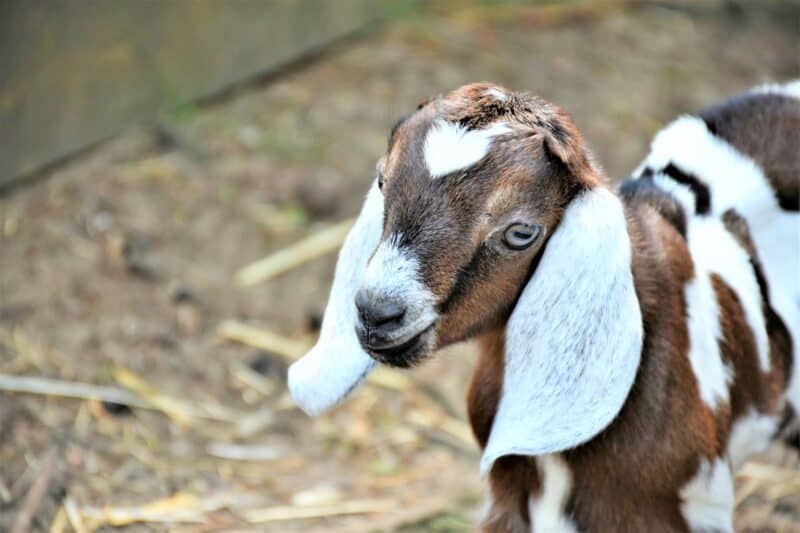
How Long Does it Take for a Boer Goat to Mature?
These large goats don’t take long to mature.
A mature doe will weigh around 190 to 230 pounds, while a buck can weigh up to 340 pounds. On average, a Boer goat stands less than three feet tall.
Most will reach sexual maturity when they are about five months old. They can breed year-round with multiple estrous cycles.
This is unusual compared to other goats, who tend to be seasonal breeders. Typically, the average doe can breed for six or more years.
Boer bucks mature at around the same time, but are more variable in terms of when they mature because it is based on the growth rate of their sires. Some can grow as fast as four pounds per day!
Bucks live around eight to 12 years, while ducks live 12 to 20. That’s much longer than many other goat breeds, to say the least.
Breeding Boer Goats
When you breed your doe, you’ll find that the first kid born is usually a singleton. Later, each doe will average two kids per birth, producing around three kid crops every two years.
You will want to plan out your breeding schedule based on when you want the meat to be available for sale.
Goat meat is in demand around certain holidays, like Christmas and Ramadan. If you can, plan things out so you will have meat available to coincide with those peaks.
The gestation period for a Boer goat is around 150 days.
Is Raising Boer Goats Profitable?
The short answer – it can be.
Raising goats, in general, has become more profitable in the United States. In fact, in less than a decade, the price of goat meat has tripled!
There are a few reasons for this.
One is that there are no religious restrictions on goat meat. It’s popular among people of all religions, but particularly those who identify as Muslim.
As chefs and restaurants look to add new, unique menu items, goat meat often surfaces as an affordable and unusual item that they can add.
Plus, goat meat is usually farmed in a free-range environment and is some of the healthiest red meat. It’s low in saturated fats and is a food staple in many countries.
Most of the goat meat we eat in the United States is imported from New Zealand or Australia, so there’s a good potential for you to capitalize on selling fresh, local meat – and Boer goats are some of the best goats to raise for meat!
How Hard are Boer Goats to Raise?
So, there you have it. Everything you need to know in order to get started with your own herd of Boer goats.
With the right knowledge – and a bit of firsthand experience – you will likely find that Boer goats aren’t all that hard to raise. Just remember to start small, and take things slow.
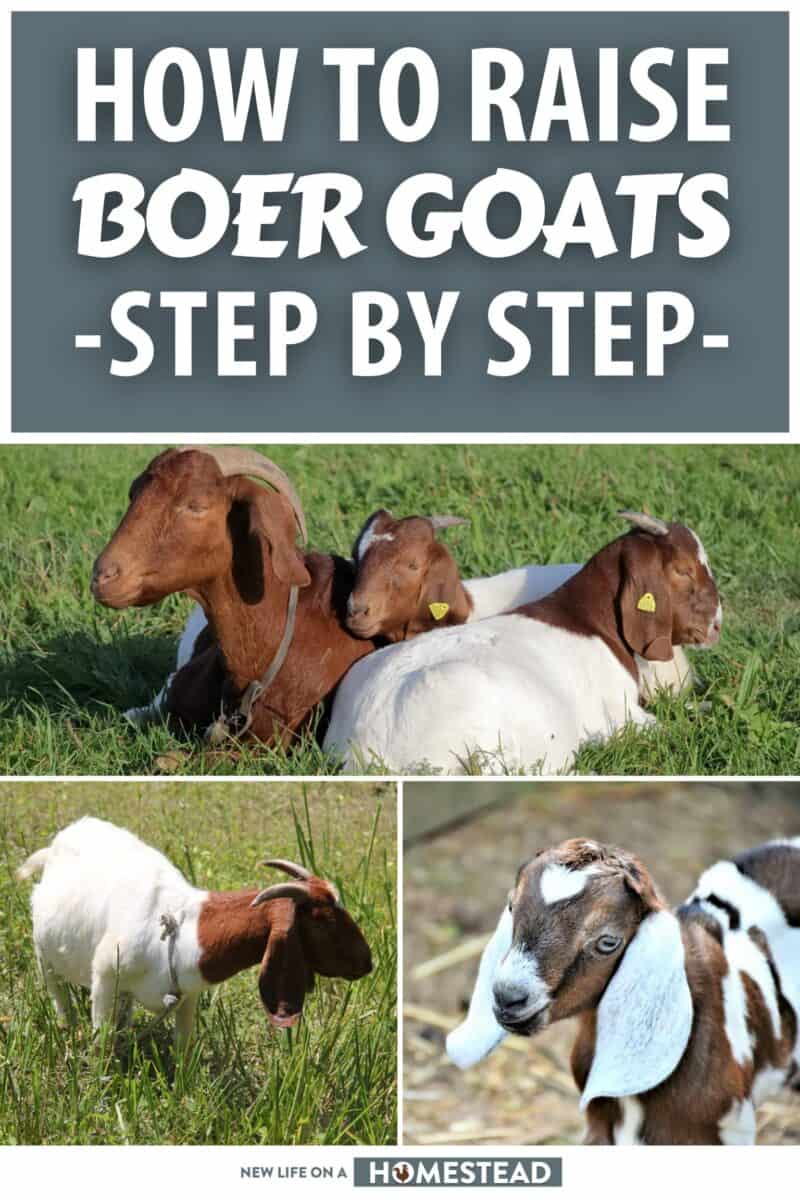

Rebekah is a high-school English teacher n New York, where she lives on a 22 acre homestead. She raises and grows chickens, bees, and veggies such as zucchini (among other things).
